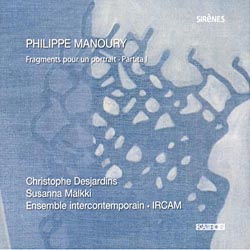 |
 |
|
Album Title: Philippe Manoury: Fragments pour un portrait &. Partita I
Performer: Susanna Mälki conductor, Christophe Desjardins viola, Ensemble Intercontemporain IRCAM
Label: Kairos
Running time: 79'59"
Recorded: IRCAM, July 2008 / September 2008
|
The name Manoury is closely linked with IRCAM, the Parisian research institute where the composer devised the cycle Sonus ex machina over a period of seven years (1987 – 1994) leading, in collaboration with mathematician Miller Puckette, to research works in the field of real time interactions between acoustic instruments and new technologies related to computer music. This last outing from Kairos introduces two Philippe Manoury compositions:
- Fragments pour un portrait (1998)
- and a more recent Partita I (2007
|
|
 |
|
The basic idea for the first composition is mainly visual and strongly inspired by painter Francis Bacon who created numerous variations of a portrait of Pope Innocence X by Velasquez. This opera delivers a kind of imaginary world portrayed in seven different approaches.
The first movement or approach "Chemins" is based on a recitativo between two of the same instruments that dialogue in commentary and imitation. "Chemins" opens with a duet of oboes subsequently joined by alto flutes and clarinets and punctuated with interjections from the strings, a mixture of clarinets and bassoons and echo effects involving the celesta, claves and anvil. This first movement in particular sounds like a slow awakening of the symphonic thematic in a very Stravinskian mood.

The darker second "Choral" seems to serve the contrast function before we enter the very swift and lively “Vagues paradoxales” where Manoury plays with Escher constructions to juxtapose the dimension of tempo with velocity. The fourth movement "Nuits avec turbulences" lead us in a multi-dimensional and mysteriously fragmentary mode, which reminds me of the Debussian concept of silent developments.
|
"Ombres" deals with a more modern Boulez atmosphere. The slightly shifted overlapping of identical elements gives rise to the impression of blurring shades so that one cannot precisely identify the parts which make up this segment.
The sixth "Bagatelle" is above all a gateway to the last "Totem" movement which become both transition and end. It harks back to the initial two movements in a very dissonant style. The last movement aims at creating large “totem blocks” as was already the case in the second movement.
The main purpose of Fragments pour un portrait is the duality of the fragmented and holistic views. The overall process consists of deconstructing foreground forms into the various constituents of the framework. Then the end of the first movement reappears in various alliterations in the following movements until a single global structure arises.
Conductor Susanna Mälkki and the Ensemble Intercontemporain are ideal performers for Philippe Manoury's work. It is a real pleasure to hear this latest performance of Manoury's orchestral music, which seems to flourish and mature over time.

The second composition represents the achievement of a project conducted over several years related to new musical and engineering methods to intensify the connection between acoustic instruments and electronics. It is on behalf of violinist Christophe Desjardins that Philippe Manoury decided to experiment with these methods inside a new musical piece for viola and electronics. His concern is the flexible spontaneous interaction between musician and machine rather than a merely passive transformation of structures.
This method consists of a light system fixed to the finger of the soloist, allowing real-time analysis of the acceleration and bow pressure variations on the strings of the instrument. Thanks to this process, a new step in the direction of an intimate relationship between the tiny variations of the instrumental performance and the control of electronic enhancements is realized. As it represents highly technical complexity, this process remains applicable at present to single instruments and cannot yet be used for a full orchestral work.
|
What results musically from this important technical achievement?
Manoury's work starts with an initial sentence of seven "sound expressions " (pointed note, regular sentence, trill, rebound, tremolo, crescendo and polyphony), then spreads out in a rigorously developed shape. Seven movements with additional introduction and conclusion respectively bring to light these seven modalities while inside each of them alternately appear six others.
The nine movements of Partita I deliver stunning diversity and richness of successive musical modes. The various interactions between Desjardins' brilliant game and the artificial echoes of electronics and loudspeakers move one inside a vertiginous musical whirlwind. Strong polarization and large tonalities always provide a rigorous path down which the listener can explore this ardent atmosphere designed by a very talented French composer.
The last movement leaving the soloist alone is a faint evocation of "Der Leiermann", the last lied of Schubert's Winterreise.
Manoury's last outing also arrives with the necessary sound engineering quality of any good contemporary music recording. For those looking for modernity in seductive contemporary music, I can highly recommend this new album.
|
|
|
| It should seriously compete on the prestigious list of 21st century classics. Despite not having sufficient experience with new classical pieces of the current century, I issue a fervent Blue Moon award for this destined-to-become new classic. |
|
 |
|